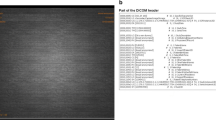Abstract
Objective
Medical imaging acquired for clinical purposes can have several legitimate secondary uses in research projects and teaching libraries. No commonly accepted solution for anonymising these images exists because the amount of personal data that should be preserved varies case by case. Our objective is to provide a flexible mechanism for anonymising Digital Imaging and Communications in Medicine (DICOM) data that meets the requirements for deployment in multicentre trials.
Methods
We reviewed our current de-identification practices and defined the relevant use cases to extract the requirements for the de-identification process. We then used these requirements in the design and implementation of the toolkit. Finally, we tested the toolkit taking as a reference those requirements, including a multicentre deployment.
Results
The toolkit successfully anonymised DICOM data from various sources. Furthermore, it was shown that it could forward anonymous data to remote destinations, remove burned-in annotations, and add tracking information to the header. The toolkit also implements the DICOM standard confidentiality mechanism.
Conclusion
A DICOM de-identification toolkit that facilitates the enforcement of privacy policies was developed. It is highly extensible, provides the necessary flexibility to account for different de-identification requirements and has a low adoption barrier for new users.




Similar content being viewed by others
Notes
There are other pieces of legislation that apply, like the common law duty of confidentiality or the Human Rights Act.
Also known as IBM De-identification Framework for Compliance to Privacy Laws.
References
The Stationery Office (1998) Data Protection Act 1998. http://www.opsi.gov.uk/acts/acts1998/19980029.htm. Accessed 20 May 2009
Medical Research Council (2000) Personal information in medical research. http://www.mrc.ac.uk/Utilities/Documentrecord/index.htm?d=MRC002452. Accessed 20 May 2009
Chen J et al (2007) Observer success rates for identification of 3D surface reconstructed facial images and implications for patient privacy and security. Proc SPIE 6516:65161B. doi: 10.1117/12.717850
NEMA (2008) The Digital Imaging and Communications in Medicine (DICOM) standard. ftp://medical.nema.org/medical/dicom/2008/. Accessed 20 May 2009
Santesof (2009) Sante DICOM Editor Integrated Anonymizer. http://www.santesoft.com/howto/anonymize.html. Accessed 25 May 2009
CTP-The RSNA Clinical Trial Processor (2009) Available via the MIRC Wiki. http://mircwiki.rsna.org/index.php?title=CTP-The_RSNA_Clinical_Trial_Processor .Accessed 25 May 2009
IBM Haifa Labs (2009) Universal De-Identification Platform. http://www.haifa.ibm.com/projects/software/udip/index.html. Accessed 7 Apr 2009
Grassroots DICOM library (2009) http://gdcm.sourceforge.net/. Accessed 30 June 2009
The SINAPSE project (2009) http://www.sinapse.ac.uk. Accessed 25 May 2009
Ellaway R et al (2006) Clinical recordings for academic non-clinical settings—CHERRI project report. http://www.jisc.ac.uk/media/documents/programmes/digitalrepositories/clinicalrecordingreport.pdf. Accessed 14 Sept 2009
Pianykh OS (2008) Digital Imaging and Communications in Medicine (DICOM): a practical introduction and survival guide. Springer, Heidelberg Berlin New York
The JNT Association (2009) Introduction to SuperJANET5. http://www.webarchive.ja.net/sj5/introductionsj5.html. Accessed 5 Aug 2009
Biomedical Informatics Research Network (BIRN) Data Repository (2009) http://www.nbirn.net/bdr. Accessed 16 Sept 2009
PixelMed (2009) http://www.pixelmed.com/. Accessed 15 May 2009
dcm4che2.org (2009) dcm4che2 DICOM Toolkit. http://www.dcm4che.org/confluence/display/d2/dcm4che2+DICOM+Toolkit. Accessed 15 May 2009
W3C (2008) XML signature syntax and processing, 2nd edn. W3c recommendation 10 June 2008. http://www.w3.org/TR/xmldsig-core/. Accessed 31 July 2009
Wang JZ, Bilello M, Wiederhold G (1997) A textual information detection and elimination system for secure medical image distribution. Proc AMIA Annu Fall Symp 1997:896
Acknowledgements
This work was funded by the SINAPSE collaboration (www.sinapse.ac.uk), a Pooling Initiative funded by the Scottish Funding Council and the Chief Scientist Office of the Scottish Executive. It was undertaken at the SFC Brain Imaging Research Centre, Division of Clinical Neurosciences, University of Edinburgh (www.sbirc.ed.ac.uk) and the National e-Science Centre, School of Informatics, University of Edinburgh (research.nesc.ac.uk), both members of SINAPSE. Two of the authors, D. Rodríguez González and J. Wardlaw, are funded by the SINAPSE collaboration, while J.I. van Hemert and T. Carpenter are also members of the collaboration. T. Carpenter is funded by the Cohen Charitable Trust and the Wellcome Trust IT grant 077393/Z/05/Z.
Data used for this study were downloaded from the Biomedical Informatics Research Network (BIRN) Data Repository (http://www.nbirn.net/bdr), supported by grants to the BIRN Coordinating Center (U24-RR019701), Function BIRN (U24-RR021992), Morphometry BIRN (U24-RR021382), and Mouse BIRN (U24-RR021760) Testbeds funded by the National Center for Research Resources at the National Institutes of Health, USA.
Author information
Authors and Affiliations
Corresponding author
Additional information
All authors are affiliated to the SINAPSE collaboration (www.sinapse.ac.uk)
Rights and permissions
About this article
Cite this article
Rodríguez González, D., Carpenter, T., van Hemert, J.I. et al. An open source toolkit for medical imaging de-identification. Eur Radiol 20, 1896–1904 (2010). https://doi.org/10.1007/s00330-010-1745-3
Received:
Accepted:
Published:
Issue Date:
DOI: https://doi.org/10.1007/s00330-010-1745-3




